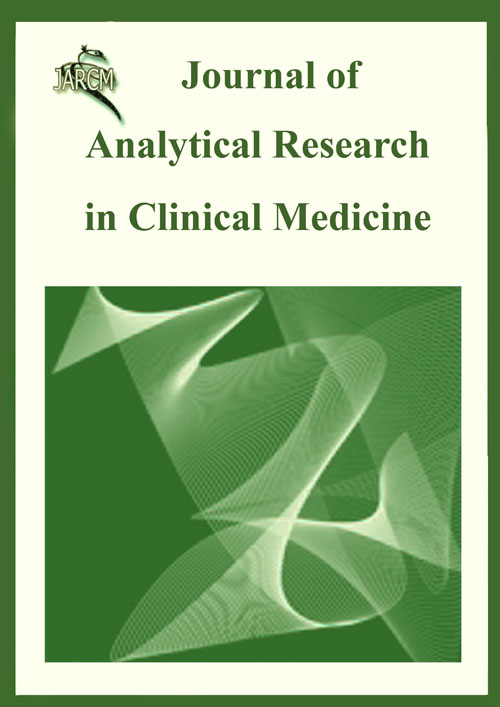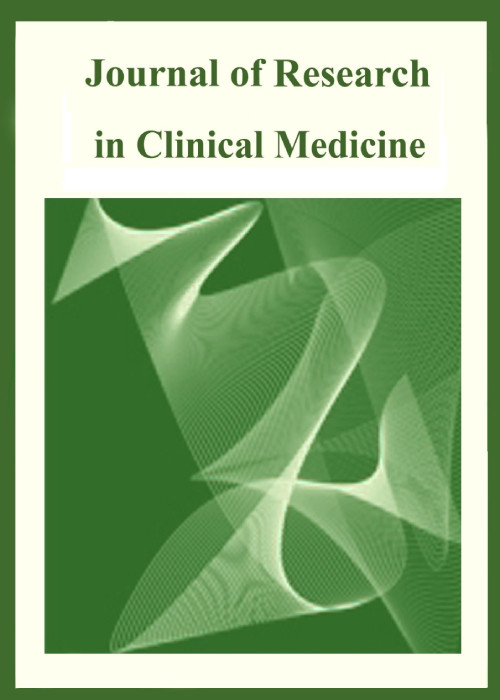فهرست مطالب

Journal of Analytical Research in Clinical Medicine
Volume:6 Issue: 4, Autumn 2018
- تاریخ انتشار: 1397/09/03
- تعداد عناوین: 7
-
Pages 149-153IntroductionCough variant asthma (CVA) is known by airway Hyper responsiveness and nonproductive chronic cough without wheezing for a minimum duration of 8 weeks. It is less common form of asthma. This study was conducted aiming to diagnose the role of serum Immunoglobulin E (IgE) in diagnosis of cough variant form of the disease.MethodsIn this cross sectional study, 80 patients with an age range of 5-14 years were included with clinical criteria for CVA who referred to pulmonology clinic of Tabriz Children Hospital, Tabriz, Iran. Serum IgE level was measured and severity of CVA based on Global Initiative for Asthma (GINA) classification was determined, finally the relationship between serum IgE level and severity of CVA was evaluated.ResultsIn patients with CVA without history of allergic disease, mean serum titer of IgE was 138.2 ± 17.5. Significant difference of serum IgE level in different severities of CVA was detected (P = 0.001).ConclusionSerum IgE level in patients with CVA is a reliable marker for diagnosis and evaluation of the severity of disease.Keywords: Immunoglobulin E, Cough, Asthma
-
Pages 153-157IntroductionPeritonitis is one of the most common complications of peritoneal dialysis. On the other hand, reduced levels of immunoglobulins (Igs), mainly IgG, can increase the risk of infection in various pathologic conditions. Here, we aimed to determine the association of severity and frequency of peritonitis with serum IgG levels in peritoneal dialysis patients.Methods100 patients with chronic renal failure referred to Imam Reza Hospital, Tabriz, Iran, for peritoneal dialysis were included in the study. Serum IgG levels were measured in all of these patients at the beginning of the study and after six months of follow-up. In case of peritonitis, serum IgG levels were also measured, and samples were sent to Imam Reza Hospital laboratory for analysis.Results40 cases (40%) were women, and 60 cases (60%) were men with a mean age of 47 years. 24 cases (24.0%) had at least one episode of peritonitis during the study. Among those with peritonitis, 14 cases (60.9%) had at least one more peritonitis episode in the 6-month follow up. The mean serum IgG levels were 1079 mg/dl and 429 mg/dl at the beginning and after six months of follow up, respectively. The difference was shown to be statistically significant (P = 0.006). There was no correlation between serum IgG level reduction and peritonitis in these patients (P > 0.999).ConclusionThis study found reduced levels of serum IgG in patients undergoing peritoneal dialysis. However, it was not associated with increased risk of peritonitis in these patients.Keywords: Immunoglobulin G, Peritonitis, Secondary Peritonitisperitonitis, Peritoneal Dialysis
-
Pages 158-164IntroductionIn Islamic countries, the prenatal diagnostic procedures are planned considering legal and religious limitations. We aimed to evaluate the indications of presentation and problems related to religious and legal limitations for presentation of Muslim parents for prenatal screening of chromosomal abnormalities.MethodsA cross-sectional study was performed on consecutive 920 pregnant women presenting for screening of congenital and chromosomal anomalies to Educational Medical Centers of Tabriz University of Medical Sciences, Tabriz, Iran, between 2011 and 2015. Previously prepared questionnaire forms were utilized for collection of information from patients and their medical records.ResultsIn total, 153 cases had an indication for amniocentesis, and this procedure revealed that 141 fetuses (92.2%) did not have any congenital abnormalities, but 12 cases (7.8%) had some sort of abnormality, requiring pregnancy termination. These cases included 8 fetuses (5.2%) with trisomy and four (2.6%) with single gene diseases. Of 12 patients, the justifications for pregnancy termination were issued for 7 women by the provincial Legal Medicine Organization. However, the remaining 5 patients could not obtain legal justifications for termination of their pregnancies, mostly because of late presentation, obligating them to choose illegal methods for pregnancy termination.ConclusionRegarding the legal and religious limitation of pregnancy termination after 18th week in Islamic countries, it is highly recommended that the first trimester screening programs be performed in Islamic countries in order to obtain early decision-making.Keywords: Pregnancy Termination, Islam, Abortion
-
Pages 165-171IntroductionDyslipidemia is one of the most common problems in hemodialysis patients and healthcare system. Some studies have suggested the use of carnitine in the treatment of dyslipidemia in hemodialysis patients. This study was carried out aiming to evaluate the effect of atorvastatin and carnitine combination versus atorvastatin alone on the lipid profile of hemodialyzed patients.MethodsIn this clinical trial, 50 hemodialysis patients referred to the educational centres of Tabriz University of Medical Sciences, Tabriz, Iran, for haemodialysis were enrolled. Patients were randomly assigned into two groups. In the first group, patients were treated with carnitine (1000 mg three times daily) and atorvastatin (10-80 mg/day based on the baseline lipid profile of the patients) and in the second group, the patients were treated with atorvastatin alone for six months. The levels of triglyceride (TG), cholesterol, low-density lipoprotein (LDL), high-density lipoprotein (HDL), and haemoglobin before and after intervention were compared. The side effects of carnitine administration were also evaluated.ResultsResults showed that TG, cholesterol, and LDL levels were significantly lower in the carnitine group compared to those in the other group at the end of study (P < 0.050). In addition, HDL and haemoglobin levels were significantly higher in the carnitine group in comparison to the other group (P < 0.050). No major side effects of carnitine were observed among the patients.ConclusionThe use of carnitine plus atorvastatin combination is an effective and safe method in the treatment of dyslipidemia in patients undergoing hemodialysis without imposing significant side effects.Keywords: Carnitine, Atorvastatin, Hemodialysis, Dyslipidemia
-
Pages 172-178IntroductionST-elevation myocardial infarction (STEMI) is a relatively common cause of mortality among patients. The effects of risk factors as predictors of mortality in patients has been shown in different studies. The present study was performed aiming to evaluate the association between a family history of premature coronary artery diseases (CADs) with clinical outcomes among patients treated with percutaneous coronary intervention (PCI) for STEMI.MethodsThis descriptive-analytical study was conducted in Shahid Madani Hospital of Tabriz University of Medical Sciences, Tabriz, Iran, on 200 patients with STEMI with a PCI. 100 out of these 200 patients had a family history of premature CAD. Patients were followed up within 48 hours after PCI, as well as one year after admission, and the secondary outcomes including myocardial infarction (MI), heart failure, ventricular arrhythmias (VAs), pulmonary edema, and death were evaluated.ResultsThe mean age of the patients with positive and negative family history of premature CAD was 56.37 ± 8.20 and 61.72 ± 7.42 years, respectively. The mean age of the patients with a family history of a premature CAD was significantly lower than that of patients without a family history of a premature CAD (P = 0.001). There was no significant difference in the frequency of CAD risk factors, angiographic findings, and its complications, ST-segment resolution and frequency of secondary outcomes during 48 hours and one year after admission between the study groups (P > 0.050).ConclusionThe present study showed that a family history of premature CAD does not predict the clinical outcomes in patients treated with PCI for STEMI which should be validated across future studies.Keywords: Family Medical History, Coronary Artery Disease, Percutaneous Coronary Intervention
-
Pages 179-185IntroductionGastric cancer is a rather common malignancy worldwide and a major healthcare system issue. Lately, the importance of biomarkers such as macrophage migration inhibitory factor (MIF) has been demonstrated in the diagnosis of various gastrointestinal (GI) malignancies. The present study aimed to evaluate the diagnostic value of MIF, carcinoembryonic antigen (CEA), and carbohydrate antigen 19-9 (CA 19-9) in gastric cancer.MethodsIn this descriptive-analytical study, 84 patients with gastric cancer referred to the gastroenterology clinic of Tabriz University of Medical Sciences, Tabriz, Iran, for diagnostic and therapeutic procedures, and 80 healthy individuals were enrolled. Serum levels of MIF, CEA, and CA 19-9 were measured in both groups. Further, the grade and stage of the cancer were determined in in the patient group.ResultsSerum levels of all three MIF, CEA, and CA 19-9 biomarkers in patients with gastric cancer were significantly higher than those of the control group (P = 0.001). However, no statistically significant correlations were found between the studied biomarkers with the tumor grade and stage. The MIF cut-off point for the diagnosis of gastric cancer was found to be 7.05 pg/ml and its sensitivity and specificity were 85.7% and 73.8%, respectively.ConclusionMIF biomarker may involve in the pathogenesis and development of gastric cancer and it is a potential diagnostic and therapeutic marker in this malignancy.Keywords: Gastric cancer, Tumor Marker, Macrophage Inhibitory Factor, Carcinoembryonic Antigen, Carbohydrate Antigen 19-9
-
Pages 186-190IntroductionGenital infection with papilloma virus is the most common sexually-transmitted disease (STD). It is recommended that individuals who have a sexual risk factor, should be screened for syphilis, human immunodeficiency virus (HIV), and hepatitis B and C. However, this strategy is often not carried out in Iran. In the present study, patients with genital warts were screened for syphilis, HIV, and hepatitis B and C.MethodsWe evaluated 311 patients with anogenital warts visiting dermatology clinics from June 2016 to June 2017. In addition, demographic data were collected using a pre-designed questionnaire. Patients who presented to Sina Hospital, Tabriz, Iran, were examined for HIV, syphilis, hepatitis B and C, urethral and vaginal discharge, and history of painful genital lesions, while patients presenting to Bahar Behavioral Disease Counseling Center of Tabriz were examined only for HIV. Data were analyzed using chi-square and Fisher’s exact tests via SPSS software.ResultsOut of 263 cases with genital warts presenting to Sina Hospital, 1, 1, and 2 cases were positive for HIV, syphilis, and hepatitis B, respectively. At the same time, one of the patients presenting to Bahar Center showed HIV infection.ConclusionWe found two HIV-positive, two hepatitis B virus (HBV)-positive, and one syphilis cases in 311 patients with genital warts, so it is recommended to assess these tests routinely in high-risk individuals with genital warts, including multi-partner and addicted patients.Keywords: Human Immunodeficiency Virus_Hepatitis B Virus_Hepatitis C Virus_Syphilis_Genital Wart


